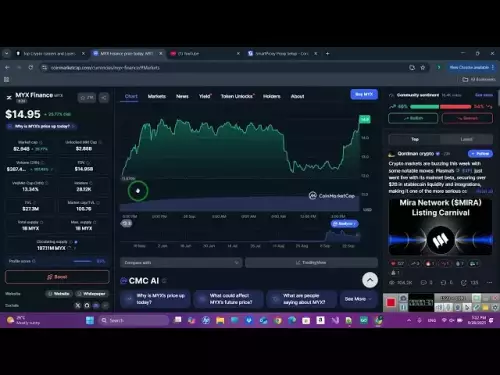-
 bitcoin
bitcoin $109547.008142 USD
0.04% -
 ethereum
ethereum $4011.838726 USD
-0.05% -
 tether
tether $1.000402 USD
-0.01% -
 xrp
xrp $2.798606 USD
0.88% -
 bnb
bnb $970.877944 USD
1.39% -
 solana
solana $202.237275 USD
-0.95% -
 usd-coin
usd-coin $0.999673 USD
0.00% -
 dogecoin
dogecoin $0.229294 USD
-1.15% -
 tron
tron $0.336370 USD
-0.45% -
 cardano
cardano $0.777260 USD
-1.66% -
 hyperliquid
hyperliquid $45.503019 USD
1.73% -
 ethena-usde
ethena-usde $1.000362 USD
0.01% -
 chainlink
chainlink $20.785303 USD
-1.10% -
 avalanche
avalanche $28.755822 USD
-0.11% -
 stellar
stellar $0.358303 USD
-0.48%
Do indicators work better on a logarithmic or linear scale for Bitcoin's long-term chart?
Bitcoin's long-term trends are best analyzed using logarithmic charts, as they accurately reflect proportional price changes and historical volatility.
Jul 08, 2025 at 01:42 pm

Understanding Chart Scales in Cryptocurrency Trading
In cryptocurrency trading, particularly for analyzing Bitcoin's long-term trends, chart scales play a crucial role in interpreting price movements. Two primary types of scales are used: linear and logarithmic. Each scale presents data differently, affecting how traders perceive gains, losses, and overall market behavior.
A linear scale, also known as an arithmetic scale, represents price changes with equal spacing between values. This means that the distance between $10,000 and $20,000 is the same as between $20,000 and $30,000. While this may seem intuitive, it can distort perception during periods of high volatility or exponential growth.
Conversely, a logarithmic scale measures percentage changes rather than absolute price differences. On such a scale, each doubling of price (e.g., from $10,000 to $20,000) occupies the same vertical space on the chart. This makes logarithmic charts more effective at visualizing long-term growth patterns, especially for assets like Bitcoin that have experienced massive rallies over time.
Why Bitcoin’s Long-Term Price Behavior Favors Logarithmic Scaling
Bitcoin has undergone several bull and bear cycles since its inception. These cycles often involve dramatic percentage increases followed by corrections. Using a logarithmic scale helps normalize these swings, allowing traders to better assess the magnitude of moves relative to prior levels.
For example, a 50% drop from $60,000 feels much more significant than a 50% drop from $10,000 when viewed on a linear scale. However, on a logarithmic scale, both drops appear proportional, which provides a clearer picture of historical volatility and trend strength.
Additionally, technical indicators such as moving averages and Fibonacci retracements behave differently depending on the scale used. When applied to a logarithmic chart, these tools reflect proportional relationships rather than absolute ones, aligning more closely with how markets actually function over extended periods.
How Indicators Perform Differently on Linear vs. Logarithmic Charts
Technical indicators are mathematical calculations based on price and volume data. Their visual representation changes depending on the scale of the chart.
On a linear chart, moving averages like the 200-day MA might appear steeper during strong uptrends, potentially giving false signals about trend strength or exhaustion. Similarly, Bollinger Bands and RSI readings may look distorted during large price surges because they’re calculated using fixed dollar amounts.
In contrast, applying the same indicators on a logarithmic scale ensures that their behavior reflects consistent percentage-based changes. For instance, a 20-period moving average on a log chart will show smoother transitions across different price ranges. This allows traders to compare current momentum with past performance more accurately.
It's important to note that while most charting platforms allow switching between scales, the underlying indicator formulas remain unchanged. The difference lies solely in how the data is visually represented.
Practical Steps to Apply Logarithmic Scaling on Bitcoin Charts
If you're analyzing Bitcoin's long-term trajectory and want to apply logarithmic scaling effectively, follow these steps:
- Open your preferred charting platform (such as TradingView, CoinMarketCap, or Binance).
- Navigate to the Bitcoin chart and ensure the time frame is set to weekly or monthly for long-term analysis.
- Look for the 'Scale' or 'Chart Settings' option, usually located near the top or right-hand side of the interface.
- Toggle the setting from 'Linear' to 'Log Scale'.
- Observe how price action appears compressed during high-growth phases and stretched during low-growth periods.
- Reapply your favorite indicators (like MACD, RSI, or moving averages) and compare their behavior before and after the scale change.
By following these steps, you'll gain a more accurate understanding of Bitcoin’s long-term behavior, especially during major market cycles.
Common Misinterpretations on Linear Charts and How Log Avoids Them
Traders often misinterpret trends when using linear charts for long-term Bitcoin analysis. One common mistake is assuming that recent sharp price increases indicate stronger momentum compared to earlier rallies, simply because they occupy more vertical space on the chart.
Another issue arises when drawing support and resistance lines. A level that held at $10,000 might not carry the same weight at $50,000 if analyzed on a linear scale. However, on a logarithmic chart, those levels maintain proportionality, making it easier to identify meaningful historical reference points.
Also, Fibonacci retracement levels tend to be more reliable on a log scale. Since Fibonacci is based on percentage relationships, applying it on a percentage-based chart aligns the tool with its intended purpose.
When to Use Linear Scales Despite Their Limitations
While logarithmic charts offer advantages for long-term analysis, there are scenarios where linear scales are preferable. Short-term traders focusing on small price ranges—such as intraday or swing traders—often benefit from the clarity provided by linear charts.
In tightly ranged markets, the linear scale offers a straightforward view of support and resistance without the compression effect seen on log charts. Additionally, some candlestick patterns and volume spikes are easier to interpret on a linear scale due to their uniform spacing.
Ultimately, the choice depends on the trader’s strategy and time horizon. Those evaluating Bitcoin's decade-long journey should prioritize logarithmic scaling, while day traders or scalpers may find value in sticking with linear representations.
Frequently Asked Questions
Q: Can I switch between logarithmic and linear scales on most crypto platforms?Yes, most modern charting tools including TradingView, Binance, and Kraken allow users to toggle between logarithmic and linear scales with just a few clicks.
Q: Do volume indicators also change appearance on a logarithmic scale?No, volume bars remain unaffected by the price scale. However, overlaying volume with a log-scaled price chart can provide better context for assessing buying or selling pressure during major price swings.
Q: Is it possible to use a semi-log chart for Bitcoin analysis?Yes, a semi-log chart applies logarithmic scaling only to the Y-axis (price), while keeping the X-axis (time) linear. This is the standard approach when analyzing long-term crypto charts.
Q: Are all technical indicators equally effective on logarithmic charts?Most indicators perform well on logarithmic charts, but certain tools like Ichimoku Cloud or Gann angles may require adjustments to account for the scale change. Always test them visually before making decisions.
Disclaimer:info@kdj.com
The information provided is not trading advice. kdj.com does not assume any responsibility for any investments made based on the information provided in this article. Cryptocurrencies are highly volatile and it is highly recommended that you invest with caution after thorough research!
If you believe that the content used on this website infringes your copyright, please contact us immediately (info@kdj.com) and we will delete it promptly.
- Snorter Bot: Your Ticket to 100x Crypto Presale Gems?
- 2025-09-29 06:25:16
- XRP Payments, Daily Wages, and Ripple Chief: A Revolution in Payroll?
- 2025-09-29 06:25:16
- XRP, Ripple, and the SWIFT Payments Revolution: A New Era?
- 2025-09-29 06:30:01
- RedotPay, Stablecoin, and Investment: A New Era of Digital Finance?
- 2025-09-29 06:30:01
- MoonBull: The Crypto to Watch in Q4 2025 for APY Rewards
- 2025-09-29 06:30:01
- MoonBull Presale: The Meme Coin Opportunity You Can't Miss (NY Edition)
- 2025-09-29 06:30:12
Related knowledge

Why is Bitcoin considered a revolutionary technology?
Aug 12,2025 at 08:29pm
Decentralization and the Elimination of Central AuthoritiesThe core innovation behind Bitcoin lies in its decentralized architecture, which fundamenta...

Why is Bitcoin considered a revolutionary technology?
Aug 10,2025 at 07:42pm
Decentralized Architecture and Trustless TransactionsBitcoin is considered revolutionary because it introduced a decentralized architecture that opera...

What are the key features of Bitcoin?
Aug 10,2025 at 02:50am
Decentralization and Peer-to-Peer NetworkOne of the most defining characteristics of Bitcoin is its decentralized nature. Unlike traditional financial...

Can the Bitcoin protocol be changed?
Aug 07,2025 at 01:16pm
Understanding the Bitcoin ProtocolThe Bitcoin protocol is the foundational set of rules that govern how the Bitcoin network operates. It defines every...

Can the Bitcoin protocol be changed?
Aug 11,2025 at 01:01am
Understanding the Bitcoin Protocol StructureThe Bitcoin protocol is the foundational set of rules that govern how the Bitcoin network operates. These ...

What happens to Bitcoin transactions once they are confirmed?
Aug 09,2025 at 05:22am
Understanding Bitcoin Transaction ConfirmationWhen a Bitcoin transaction is initiated, it is broadcast to the network and placed in a pool of unconfir...

Why is Bitcoin considered a revolutionary technology?
Aug 12,2025 at 08:29pm
Decentralization and the Elimination of Central AuthoritiesThe core innovation behind Bitcoin lies in its decentralized architecture, which fundamenta...

Why is Bitcoin considered a revolutionary technology?
Aug 10,2025 at 07:42pm
Decentralized Architecture and Trustless TransactionsBitcoin is considered revolutionary because it introduced a decentralized architecture that opera...

What are the key features of Bitcoin?
Aug 10,2025 at 02:50am
Decentralization and Peer-to-Peer NetworkOne of the most defining characteristics of Bitcoin is its decentralized nature. Unlike traditional financial...

Can the Bitcoin protocol be changed?
Aug 07,2025 at 01:16pm
Understanding the Bitcoin ProtocolThe Bitcoin protocol is the foundational set of rules that govern how the Bitcoin network operates. It defines every...

Can the Bitcoin protocol be changed?
Aug 11,2025 at 01:01am
Understanding the Bitcoin Protocol StructureThe Bitcoin protocol is the foundational set of rules that govern how the Bitcoin network operates. These ...

What happens to Bitcoin transactions once they are confirmed?
Aug 09,2025 at 05:22am
Understanding Bitcoin Transaction ConfirmationWhen a Bitcoin transaction is initiated, it is broadcast to the network and placed in a pool of unconfir...
See all articles










































































